Since you’re reading this post, you’ve essentially told me that you’re currently overweight and have a lot of fat to lose (or maybe just a couple pounds).
You’re wondering how to get lean.
That’s perfectly fine, and in fact, you’re not alone.
Many other people are in this exact situation, including myself when I first started.
I know exactly what it feels like to be at this stage. It feels like you’re a long way off the path that you should be on.
Don’t worry, I’m not someone who’s been skinny their entire life and going to tell you “just put the fork down.”

When I was at this point in my life, the very sight of myself in the mirror was very discouraging.
It wasn’t until I started to change things in my life and got a better understanding of the importance of lifting weights and nutrition, that things began to change.
So that’s the good news.
That you CAN change your current physique state.
It’s possible to gain some quality, lean muscle, lose fat, and, become leaner and stronger.
That’s what this guide is all about.
It’s not going to be easy, but I am here to help show you the way, so let’s get started.
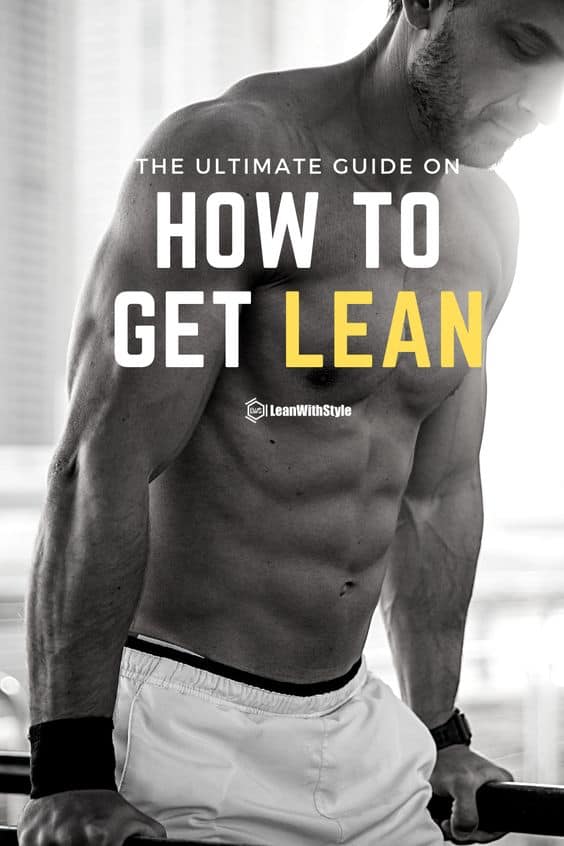
The Hierarchy: How to Get Lean
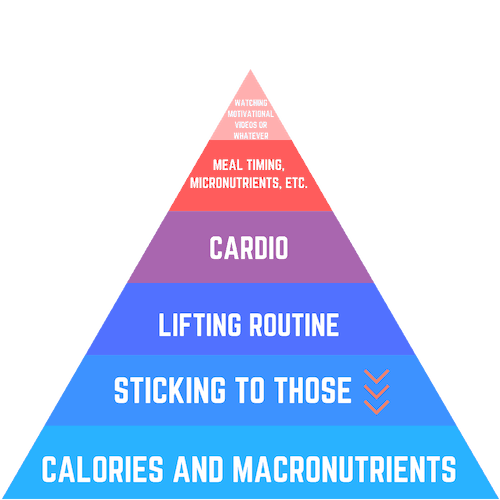
As you can see from the pyramid above, your calories and macronutrients are MOST important.
Lifting weights are important, but it won’t matter unless your calories and macronutrients are in place.
After lifting weights comes cardio.
Cardio is not necessary to get the body you desire. Cardio can help, yet, you shouldn’t get rid of cardio altogether. Cardio enables you to stay conditioned which is important for your health.
After cardio is meal timing and how many meals to eat, along with micronutrients and other minutiae.
Then, finally, watching motivational videos and other little things to keep you going. As you can see, it won’t get you very far on its own.
Remember this hierarchy whenever you seem stuck. If something isn’t in the right order, everything falls apart.
We’re going to go over most of the hierarchy in more detail to give you a better overview of how to drop fat.
The first step to take on the way to get lean is your calories and macronutrients.
Getting Lean – Calories and Macros Explained

Your first step on your way to “leanness” is to calculate your Caloric Deficit (the calories required to eat to lose weight).
There’s no way to get a lean body unless you drop a significant amount of fat first.
Same with lifting weights (although I do recommend you start regardless of where you are in your fitness journey).
For the purpose of this guide, I’m assuming you have at least 30-50 pounds to lose. Let’s figure out how to lose those pounds first.
Step 1: Find Your Weight Loss Calories
- To do this:
- You first want to multiply your body weight by 14, 15, or 16 (depending on your activity level throughout the week– example down below)
- Whatever number you get, subtract 25% from it and you have found your calorie deficit for losing body fat rapidly (but not too rapidly).
- I have an entire article going more in-depth on calories for losing weight. If you want to learn more, read this article.
For the purpose of this article, we will use my calories as an example.
Here’s the formula on how I calculated them:
The Formula for Maintenance Calories:
Body weight (in lbs.) x 14, 15, or 16.
- If you are sedentary, choose 14. in this formula, it would be someone who only gets activity through the gym and nothing else.
- If you are lightly active, choose 15 (Lightly Active means you workout 3-5 times per week, but also don’t sit around all day – fits most people).
- Choose 16 if you’re very active (Very Active means you workout 3-6 times per week, but you also move around constantly due to work, or other activities other than the gym)
- Again, read this post to figure out which option best suits you.
Example: My body weight is 204lbs.
204 lbs x 14 = 2855 calories.
These are the number of calories I would eat every day if I wanted to MAINTAIN my weight.
To find the calories to eat to lose weight:
Formula for Calorie Deficit:
2870 x .75 =
2140 calories to eat per day to lose weight. (I’m going to round up to 2150)
Now, do this for your own body weight stats and move on to the next section on macros:
Macronutrients for Getting Lean
I’ve written an entire book on macronutrients and how to track them, so I won’t go over everything here, however, you must know that your macronutrient “split” is essential when it comes to body composition (how you end up looking).
Gone are the days of following a boring meal plan. IIFYM allows you to eat your favorite foods while transforming your body.
Here are some of the things that you will learn inside:
- How to lose fat and get in shape all while eating the foods you love including pizza, ice cream, pancakes, and more!
- How weight loss and weight gain happen and how to avoid gaining weight.
- The quantity of each macronutrient that you need and how to use calories, and “macros” for better body composition.
- The difference between enjoying the fat loss process (IIFYM approach) and being miserable (traditional dieting)
- How to use the IIFYM method of dieting with today's technology!
- How to create your own meal plan for maximum fat loss effectiveness and to maintain a healthy lifestyle.
- How to use our IIFYM Restaurant guide to simplify dining out.
- An in-depth FAQ section to answer your meal plan creation questions to get the most out of IIFYM
- And much more...
I cannot stress enough how important getting this right is.
If you do not follow the caloric and macronutrient recommendations, you will fail to obtain your goal, I promise you that.
Remember the hierarchy.
If this part doesn’t work, everything else falls apart.
Protein, Fats, and Carbohydrates
Let’s go over your “macro split.”
Protein
Usually, I would recommend 1 gram of protein per lb. of body weight, however, because you have a lot of fat to lose and are a bit overweight, that would be a LOT of protein to eat.
Most people, especially those who’re beginners, have a hard time adjusting to the recommended protein intake of any workout/diet program.
I get it. If this is the case for you, I’d recommend going as low as 0.7 grams of protein per pound of body weight until you can tolerate eating more protein.
Carbs
Carbs are NOT the enemy when getting lean. In fact, I recommend for most people to increase your carb intake at times to fuel your workouts.
Carbs are necessary for a lot of things and you don’t need to give them up just because you’re trying to lose weight.
All that matters is that you are in a calorie deficit and as long as you do that and follow your macros, your carb intake should not decrease.
Fats
Fat is necessary for a multitude of functions in the body which I won’t go over right now.
Just know that you don’t ever want to go under 20% in your diet.
That’s the limit.
That being said, you could go higher, just make sure you’re getting enough protein (at least 0.7-1.2g of protein per pound of body weight).
The Lifting Routine For Getting Lean

Train Heavy Three Days Per Week
NOTE: This is not an end-all, be-all workout routine. If you already have a workout routine that you like and that follows the principles below, follow that. If you already workout 5 days per week, full-body, do that. IDC what workout routine you follow, so long as the principles below are followed. This is just a starting point for beginners and others alike and you are only meant to progress from this point forward.
Three times per week. That’s all you need for now. Could you do more?
Yeah.
But, I want to make this guide as accessible as possible. Therefore 3 days is all I will assign (hit me up in the comments if you want a 4 or 5-day workout split).
You’re going to make the MOST out of these 3 days to ensure you get the body you want.
There are going to be 8-Weeks of weight training workouts that you can follow.
The organization of these workouts is in the schedule below.
Day 1 can be Monday or whatever day works best for you.
Here’s the schedule:
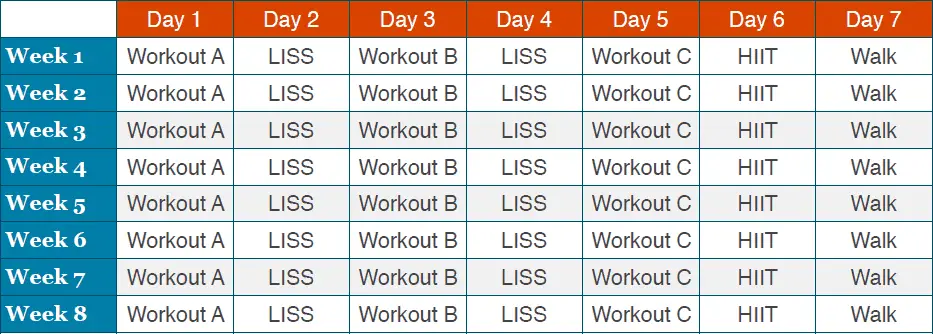
As you can see, the schedule is very simple.
Since you’re trying to get lean, I want you to do 2-3 cardio sessions per week to keep your cardiovascular health up and speed up your progress.
The workouts themselves should only take 45-60 minutes.
Here’s a Video Exercise Library to help you with how to perform the exercises, which we’re about to go over right now.
All workouts follow a Reverse Pyramid Training (RPT) Style.
If a certain exercise does not have “RPT” next to it, then it will just be a straight-set (SS) which just means to keep the same weight for all sets.
This will all make sense in a second.
| Exercise | Sets | Reps | Rest | RPT or SS |
|---|---|---|---|---|
| Barbell Overhead Press | 3 | 6-8 | 2-3 min | RPT (-5%) |
| DB/Barbell Incline Bench Press | 3 | 6-8 | 2-3 min | RPT (-5%) |
| Triceps Exercise (see notes) | 3 | 8-10 | 2-3 min | SS |
| DB Lateral Raises | 3 | 8-10 | 2-3 min | SS |
| Exercise | Sets | Reps | Rest | RPT or SS |
|---|---|---|---|---|
| Deadlifts | 3 | 6-8 | 3-4 min | RPT (-10%) |
| Row Variation (see notes) | 3 | 6-8 | 2-3 min | RPT (-5%) |
| Chin-Ups (see notes) | 3 | 8-10 | 2-3 min | RPT (-5%) |
| Hammer Curls | 3 | 8-10 | 2-3 min | SS |
| Exercise | Sets | Reps | Rest | RPT or SS |
|---|---|---|---|---|
| Squats | 3 | 6-8 | 3-4 min | RPT (-10%) |
| Romanian Deadlifts | 3 | 6-8 | 2-3 min | RPT (-5%) |
| Walking Lunges | 3 | 8-10 | 2-3 min | SS |
| Hamstring Curls (Lying or Seated) | 3 | 8-10 | 2-3 min | SS |
Workout Notes
What RPT and the Percentages Mean
Everywhere an exercise says “RPT” it means that your first set should be the heaviest and decrease as the sets go on.
For example, in Workout A, the second exercise says: “DB Incline Bench Press: 3 sets/6-8 reps/2-3min rest/RPT (-5%)”
Here’s how this would look:
1st set: 70 lbs – 6 reps
2nd set: 65 lbs – 7 reps
3rd set: 60 lbs – 8 reps
As you can see, the weight decreases by after the 1st set, and again after the 2nd set.
This is called Reverse Pyramid Training (one form of it at least).
Each time you decrease the weight, you want to get 1, maybe 2, more reps than the previous set.
The weight will not always decrease exactly by 5%.
In the example above, if you do the math, set 2 should be 66.5 lbs. However, no gym I know of has 66.5 lb dumbbells.
For that reason, on any exercise that requires DBs, just go 5 or 10 lbs lighter depending on how heavy your first set was.
The image below demonstrates how each set should look. I have put how much of a percentage decrease (5 or 10%) next to each exercise.
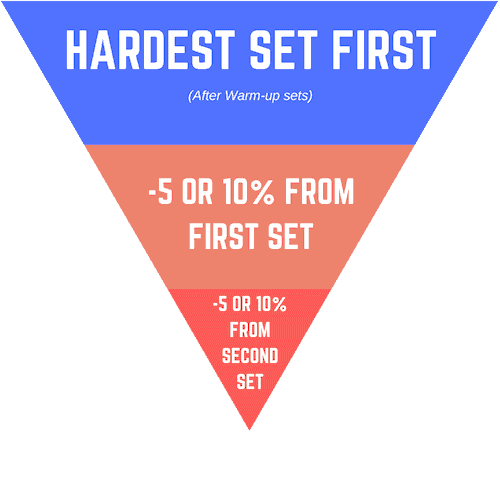
Depending on how much weight you use, this could be anywhere from a 5 lb decrease to 50 lb decrease so just open the calculator on your phone and subtract the weight you used in your first set and subtract 5 or 10% from it to get your next weight.
- Row Variation Notes:
There are so many great “row” exercises so I will leave this up to your personal preference.
My personal preference is the Pendlay Row (search “barbell row alan thrall” on YouTube or see the exercise video library above).
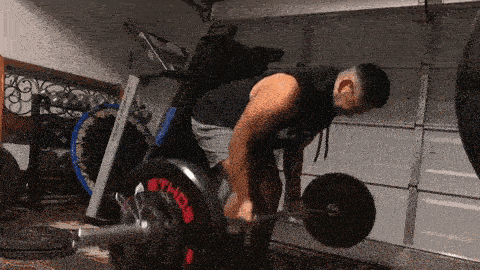
Make sure to check the exercise video library for demonstrations and proper form.
Chin-Up Notes:
I put chin-ups as an exercise because that is the ultimate goal in the end. For you to be able to do multiple chin-ups.
Chin-ups, and especially weighted chin-ups, are the ultimate sign of physical fitness.
However, you probably aren’t strong enough (yet) to do chin-ups or at least the amount prescribed, so please do assisted band pull-ups, or the lat pull-down instead for now.

You could also do regular overhand pull-ups.
After 4-weeks of doing these assistance exercises, see where you are with chin-ups.
Tips for Progressing on Chin-Ups
Extra Tip: If you want to speed up your progress with chin-ups, do some every-day.
Do 5 jumping (negative) chin-ups 3 times a day (morning, afternoon, and night).
Jumping (negative) chin-ups are where you jump up to the top of the chin-up movement and slowly go down.
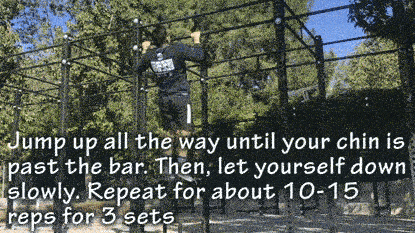
You can do pull-ups like I am doing here, or you can do chin-ups.
This will get you used to the movement and you will be able to do chin-ups in no time.
Once those 5 jumping chin-ups become easy.
Start trying normal chin-ups.
You’ll be amazed at how fast you progress.
As someone who couldn’t even do 1 before (see my progression here), I know what it takes.
Obviously, you can’t be at the gym 3 times per day so I highly recommend you get a doorway chin-up bar for your home.
I use this one because its high-quality and doesn’t ruin my door like other cheap ones. You can see my full review here.
Triceps Exercise Notes:
For your Triceps, I believe there are a lot of great exercises that you can do.
There’s the close-grip bench press, dips (triceps focus – less forward lean), Skullcrushers, rope pulldowns, etc.
Whatever you choose, make sure to control the weight. Really feel your triceps moving the weight. Don’t allow other muscles to interfere.
General Workout Notes:
Do NOT use light weights and just try and hit the rep ranges given.
For example, when you’re doing squats and you’re on your last few reps, those reps should be hard! They should not feel easy.
Lift heavy enough to where you could not get another rep with proper form.
If it says 6-8 reps, you should not be able to get a 9th rep (comfortably) with proper form with the weight you are using.
If it says 8-10 reps, you should not be able to get the 11th rep (comfortably) with proper form with the weight you are using.
Please don’t go light on the weights.
Here’s why:
If you were to do a bunch of sets and reps of certain exercises, you would be targeting something called Sarcoplasmic Hypertrophy (hypertrophy means muscle growth).
This type of muscle growth increases the fluid in the muscle making it bigger and puffier, but NOT necessarily stronger. Not what you’re going for right?
Of course not.
You want to get a stronger and leaner body right? If you answered yes, here’s what you want to do.
To get that body you desire, you must strength train and add size to the right areas by targeting Myofibrillar Hypertrophy.
This type of muscle growth is what you want! It increases the density of the muscle and makes it stronger, without making it much bigger (like the man in the picture to the left).
To simulate this type of muscle growth, you want to lift heavy.
The more and heavier you lift over time (progressive overload) the more muscular you’re going to look.
That’s why you must challenge yourself in the weight room.
Lift heavy (safely, of course) and challenge yourself and you will get the body you desire.
With that out of the way, let’s now move on to cardio.
The Cardio Routine

Notes on HIIT (High-Intensity Interval Training)
You may have noticed that there is only 1 High-Intensity Interval Training (HIIT) session a week.
Although it says to do it on day 6 (Saturday for example), you can do it on any day if you desire, however, just make sure it’s after or apart from your weight lifting.
This is for recovery reasons.
As far as what to do for your HIIT session, I recommend 20-30 minutes of either:
- sprinting,
- cycling,
- rowing
- or some form of body-weight HIIT
Notes on LISS (Low-Intensity, Steady-State) Cardio
There are 2 Low-Intensity, Steady-State (LISS) sessions per week that I want you to do.
Do the cardio between workout days or right after your lifting workout.
A sample LISS workout would be 45min on the StairMaster or walking on a incline on a treadmill machine at a low speed, or jogging at a slow pace.
You don’t want to go too slow where its super easy but you also don’t want to go too fast either.
Somewhere between “Wow, this is going to suck for a bit” and “I could do this for 45 minutes.” You’ll know when you’ve found that speed.
Aim to burn a bunch of calories with this cardio session and listen to an audiobook or watch YouTube/Netflix.
Use LISS to burn extra calories without messing up your recovery. This is why HIIT is on the weekend with an extra day of rest before hitting the gym again.
Notes on “Walk”
“Walk” means don’t sit at home all day.
Be active.
Move.
Go on a hike.
Do something.
Burn calories and don’t sit at home all day. The more active you are, the easier this whole process will be for you.
Higher activity = Higher calorie burn = faster weight loss.
If you want to get technical, go on a 1.5 to 2-hour walk and listen to an audiobook.
Enjoy nature and have some fun dammit 😀
Notes on Cardio in General
Remember that hierarchy we talked about earlier? Remember where cardio landed? It was not as important as your overall caloric and macronutrient intake.
Lifting came after and then came cardio.
If you have to miss a cardio session due to X reason, that’s fine. Just don’t miss a lifting session and stick to your calories and macronutrients.
Cardio is just for increasing your caloric deficit and of course, heart and lung health. Don’t dismiss it but don’t make it the focus of your fitness journey.
Conclusion
We’ve come to the end of your guide.
I hope this has helped you realize what you need to do and how you need to do it.
I tried to provide as much value as possible, however, if something is unclear, or you have any questions in the guide, please email me at any time at [email protected].
I will gladly try and clarify something in the guide.
Before you do email me, however, please check out my website to see if I have not already written about the topic, which you can do by clicking here.
Also, here are some other articles and pages of mine that may help you along your fitness journey:
More Resources:
- The Best Macros For Cutting (with a calculator)
- My IIFYM Guide (With a Macros Calculator)
- The 40 40 20 Diet & Why It Works
- Intermittent Fasting for Weight Loss
- How to Track Macros – The Ultimate Guide
- The 16 Best Supplements for Cutting in 2022
- My Favorite Fitness Resources and Accessories
- My If It Fits Your Macros (IIFYM) Book
Also, here are some of the social media platforms that I post on regularly. Come by and say hi!
• YouTube
Thanks again for going through the guide and I hope to talk to you soon.
– Christian Pinedo




This is an impressive article. I wish you had some products to recommend!